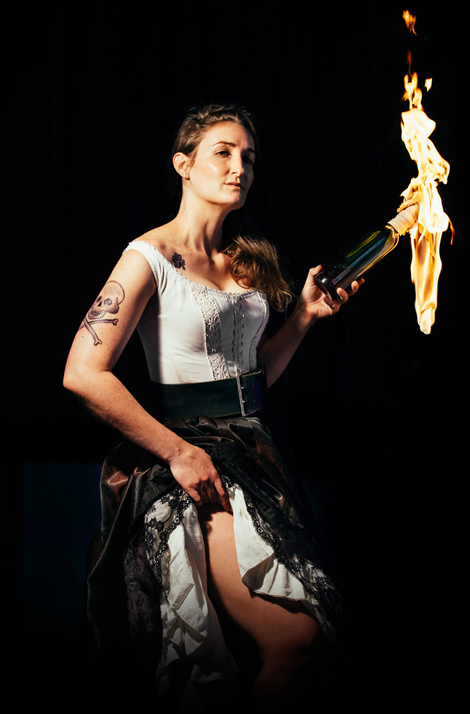goth, garage inspired theatre

Double Feature | Reviews
Lucky +
Lord Willing and the Creek Don’t Rise
June 11, 2015
MKA is a Melbourne based theatre company that formed in 2010 with the objective of promoting new Australian writing for the theatre. Recently, the company staged a double feature including Tobias Maderson-Galvin’s Lucky and Morgan Rose’s Lord Willing and the Creek Don’t Rise. Both plays were part of a season of independent Australian theatre for this year’s Neon festival. In a promotional video for Neon, the MKA team describe the company as providing an independent ‘forum for new ideas’, which is not bound by ‘corporate dollars’ or market considerations and therefore fills the gap in a largely corporate theatre industry. Companies such as Robert Reid and Anniene Tristen Stockton’s Theatre in Decay, which formed in 2000, had similar objectives and share in the Melbourne branded, post-punk larrikin aesthetic, which flourished in the self-deprecating and “self-harming” garage- grunge sensibility of the late 1990s.
If there is a genealogy to be drawn here, MKA appear to take up the mantle of Goth, garage inspired theatre – where Theatre in Decay left off about a decade ago. According to Tobias Maderson-Galvin, MKAs playwriting aesthetic merges ‘Delicatessen’ with ‘True Detective’. Like these filmic and TV references, MKA’s dramas take cheeky delight exposing serious human failings and institutional aporias. With a playful, and taxonomic fascination with death, the play texts sidle up to forms of structural human violence, colonialism, gender-based violence, cannibalism and environmental destruction.
In the context of a festival such as Neon, which takes place in Southbank theatre – a venue reserved for more established, read conventional, theatre – pushing the boundaries, even just a little bit, becomes all the more titillating and self-reflexive in a time of arts funding precarity and restructuring. The recent restructuring of the funding body of the Australia Council ushers in the newly established National Centre for Excellence in the Arts, overseen by Senator of the Arts George Brandis, who admits a keen interest in the arts’ role in celebrating Centenary, in ballet, block-buster musicals and art exhibitions. His objective is to promote excellence in the Arts by assessing whether or not an artwork adequately maps to community standards of good taste. With theatre companies such as MKA providing the kind of post-punk larrikin aesthetics that cut across the grain of what might be considered community standards in good taste, it is timely to consider the value of such work in a rapidly shifting landscape for the arts and humanities in Australia. More broadly, how does independent theatre practice reflect broader issues of censorship in public reportage and opinions that fall outside of the presumed parameters that ‘good taste’ and community standards allow?
What I hope to emphasise here is that ‘excellence’ is not an innocent aesthetic judgement about what constitutes good taste, but rather becomes an invested, political strategy. The setting of theatrical quality against an unverifiable community standard of good taste is deceptive, for example any modulations of opinion are flattened and made to align directly with a conservative account of the arts; no obscenity, nudity but not too crude, not too left wing or feminist etc; and on the other hand the arbiters of good taste may also be well versed in high-brow literature, European modernism, – or at a pinch, Italian – avant-gardism, in such a way as to give the impression of advocacy for difference in theatre. What can a conservative take on excellence do to Australian playwriting and theatrical production? ‘Excellence’ has determined the landscape and legacy for Australian playwriting, one that is still deeply suspicious of women, indigenous people and the working- poor, students, ‘leaners’ who speak out of turn. If you follow closely, there is an implicit parsing of ‘excellence’ as suspicious of ‘new Australian writing’ for theatre, particularly women playwrights.
Suffice to say here, that the landscape of Australian theatre and new writing for the theatre will probably shift again reflecting the restructuring of arts funding, from the old Australia Council to Brandis’ new National Centre for Excellence in the Arts. The Australia Council has its critics, however its principle of employing an ‘arms length’ approach to arts access and uptake, which made some provisions for independent work, is a grave concern for small, independent arts organisations with little popular or mass appeal. Excellence and good taste can be frightening affirmations and imperatives particularly when the art work is not affirmative or popular in the political sense, but a little dark, ‘obscene’, critical in ways that align with dissensus.
Tobias Manderson-Galvin’s Lucky.
Lucky resurrects a set of three familiar colonial types – an indigenous man, a cut-purse/prostitute and Irish priest – and places the characters aboard a boat, which looks as though it has been cleaved in half. Conflict between the three colonial figures ensues as ‘the Aboriginal’,’ the Woman’, ‘the Priest’, attempt to orient the ocean and compete for survival. The action on the boat appears to be symbolic of the fracture caused by colonial violence and presents a wry revisiting of the Australian nation- play. Colonial time is intermittently broken by a series of contemporised monologues given by a shy boy bullied at school, a piano mover, and a school principle opening a reconciliation garden at her school, played by the same three actors. The monologues spiral into moments of psychological rupture, intruding on the flimsy render of the ordinary lives explored in the text. Beneath the surface of civilised life with mums and dads and schools with reconciliation gardens and the winning of The America’s Cup, lies a murky legacy of the birth of a nation delivered in a spray of bullets.
The play opens with an Indigenous man donning the red coat of the invading British Infantry. He addresses the audience as a Master of Ceremonies, asking us if we are ‘feeling lucky’? The phrase ‘lucky country’ is a well-worn motif signalling prosperity, lack of class barriers, and general possibilities offered by a newly established nation, particularly alluring for overseas citizens escaping post-war Europe. The writer’s of Lucky have referenced the 1964 book by Donald Horne, The Lucky Country.
The term ‘Lucky Country’ was cynically employed soon afterwards for the attraction of cheap migrant labour. Its purpose was to attract European men and women with a capacity to assimilate to the cultural standards of a ‘White Australia’. I remember hearing the term often in primary school during the Hawke and Keating years. In the classroom, the term seemed synonymous with migration, with an emphasis on the positive outcomes of mobility, the promise of economic success for those willing to join the ‘melting-pot’ of Australian society. The unspoken caveat being that migrants adapt to the sensibilities required of a white, ‘civilised’ Australia. The play evokes the concept of the Lucky with a cynical glance toward its audience, but also with a sense of delight, as Luck belongs to the realm of the irrational, of chance, of ‘magic’, to the under dogs. There is no offer of resolution in the play, as the three colonial figures suffer their internment at sea. The watery home is unhomely, un-heimlich, set against an infinitely deferring horizon; the play signalling that the lawless are never landed.
The writers and stage design evoke a timeless, antipodean, purgatory; one that extends from the rule of the British into the economic opulence of the era of The America’s Cup, through to the Howardian time of the un-sorry. The symbolism in the three characters suggests a sublimated Christian cosmology, connecting to the legacy of European law and penal governance, casting out the tripartite Others along with their ‘future selves’; the Aboriginals, stolen kids, Women, wives, school teachers, and prostitutes and Catholic Irish, wogs and other uncivilised, religious types.
Lost at sea the others figure as ungovernable ghosts and in light of shifting tides in maritime law, which have given rise to military interventions such as ‘Operation Sovereign Borders’, the symbolism of a cleaved boat that may never arrive, takes on a particularly uncanny or terrible countenance. The dramaturgy suggests that the colonial types, each referencing an exile from their respective homes, are pressed onto the ‘same boat’ in a moment of duress. In this way the play is suggestive of an ongoing condition of un-landed dispossession, but for whom?
My question to MKA would be, do we inhabit the same boat really? Perhaps the symbolism of the cleaved boat answers this question in which the disproportionate, generational, historical inequalities imparted onto First Nation Australians suggests we are not in the same boat. On the one hand, the spatial metaphor of the cleaved boat makes sense, as it signals two different sets of governing apparatuses; one for the ‘white’s’ and another for the ‘blacks’; a dreaded and unspeakable Apartheid. The staging has the Irish priest and cut-purse prostitute on one side of the cleaved boat and the Indigenous man on the other. The symbolism is productive but its execution is perhaps a little naïve.
Morgan Rose’s Lord Willing and the Creek Don’t Rise
Set in New Orleans, Morgan Rose’s Lord Willing follows the lives of an unemployed couple and their elderly neighbour in the aftermath of hurricane Katrina. An extraordinary feature of Lord Willing is how well it maps to the Australian vernacular and idiom. I immediately leaped to the recent controversy surrounding the airing of Australian documentary series ‘Struggle Street’, which chronicles the lives of the working poor and unemployed in the Sydney suburb of Mt Druitt. The documentary was criticised for its perspective, which seemed to veer down on the town, taking voyeuristic pleasure at the level of dysfunction and economic inequality revealed in the show. Others felt Australia’s white middle-class was threatened by the realities of generational and institutional poverty and how it forces ‘us’ to feel complicit. The hidden subtext perhaps, of both the Mt Druitt TV series and Lord Willing, is that there is something alarming, difficult and seductive in witnessing the abject dysfunction of our neighbours.
Although there has been much commentary regarding the very apparent ways in which race contributed to the unequal distribution of aid from the Bush administration in the aftermath of Katrina, the play only implies it through its casting; there are no black characters in Lord Willing. What does a focus on white dispossession in states of crisis illustrate? Is this a self-reflexive looking, or perpetuation of voyeuristic gazing? I’m not sure, but if it is a voyeuristic gazing it seems to want to make us feel complicit. The character of Miss Rose for example, emaciated and sipping from a flask states at the beginning of the play, ‘We’re drunks and racists’.
Lord Willing reflects on the ambience produced by structural abandonment, the inability and neglect of governing bodies to intervene and restore ruined infrastructure, it describes the creeping in of dirty water and disease, a flooding in of excrement, limbs, dead animals and debris in the manner of Gothic encounter. These images of watery decay and neglect inform the geography and environment of the play and insinuate the workings of the characters’ inner landscapes. On the one hand the play is very much located in New Orleans, on the other hand it could be situated in any state of emergency setting. The nature of the emergency is itself fluid and ambiguous; it’s environmental in scale, but it’s also governmental, personal, emotional, sexual, and ultimately psychological.
The play doesn’t give the impression of being ideological, or overtly political, but it points to an ‘abandonment’ of human life as an effect of unequal distributions in the economy, structural complacency, the savagery of environment that strikes with flood, heat, fire, as well as the savagery of gender relations. The narrative ends with the implied suicide of a man who has eaten his girlfriend; a ghastly and literal act of incorporation of the Other. The structural abandonment of the flood- struck town resolves itself on the level of the personal and psychological as an abandonment of faculty, such that a “loved” one is cannibalised, incorporated, finished.
In the post-show discussion, Ken Gelder – from the Australian Centre at the University of Melbourne – was invited to share his thoughts on Australian Gothic. He talked about the Gothic as an encounter between different genres or categories, a zone of collision or perhaps indistinction; in the case of these two new Australian plays, the collisions between colonial and contemporary temporalities, the bodies of the young and those of the elderly, sex and death, humour and terror, city and swamp, Indigenous and non-indigenous. The Gothic evokes a feeling of ‘the uncanny’ in the Freudian sense. Freud’s theory of a child’s connection to the mother and one’s connection to the home, or in this case, the un-homely – ‘un-heimlich’ – is to do with things we are familiar with and recognise, but which at the same time manifest as alien or foreign. The un-homely or uncanny is another way of describing the water-bound aesthetics of this new Australia work, which carries forward the legacy of Theatre In Decay which shocked and irritated Melbourne audiences in the early 2000s with a similar approach to script, rough vernacular, a sense of the obscene and post-punk larrikinism. I think that the MKA plays would benefit from a period of finessing in the script, to bring greater depth to characterisation and breadth to the scenes of structural violence it explores. However, I thoroughly enjoy and revel in the rough and ready, sublimely feral approach to the script writing. There’s something deeply satisfying in the creep of this Melbourne-branded post-punk theatrical larrikinism into a mainstream venue.

